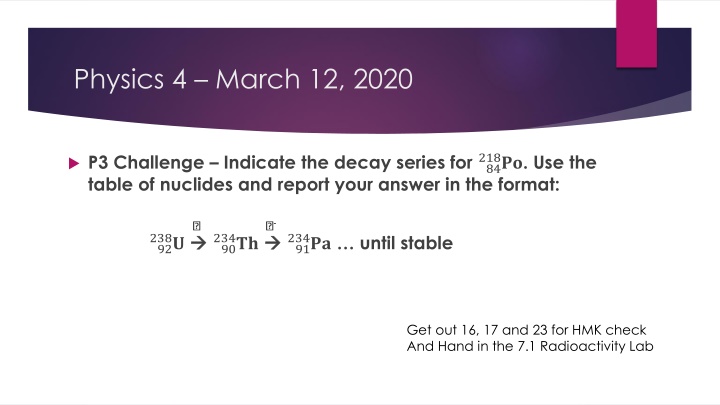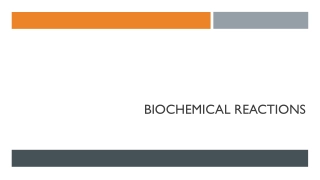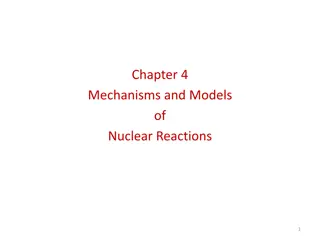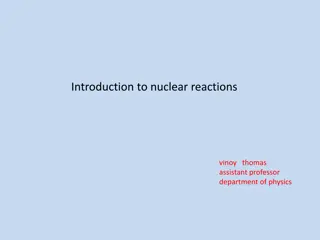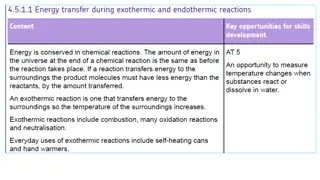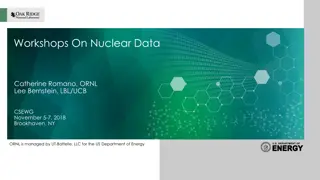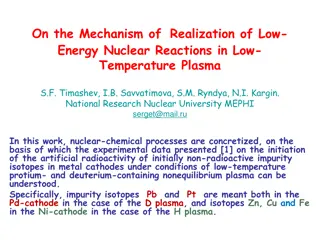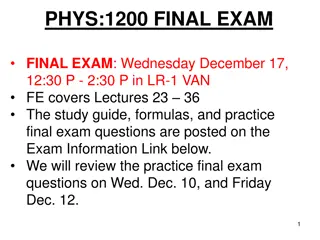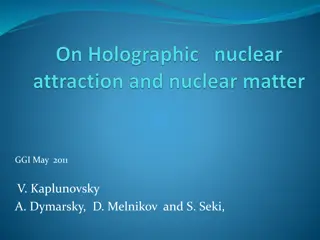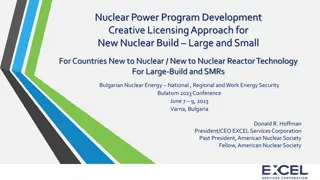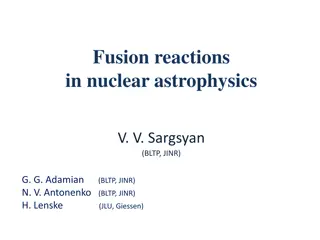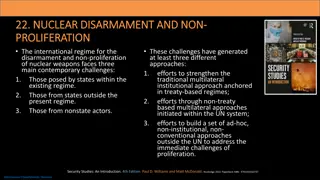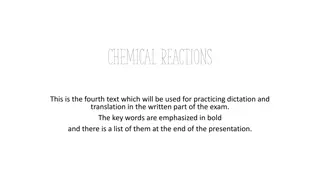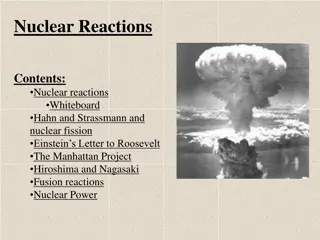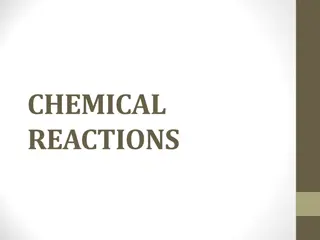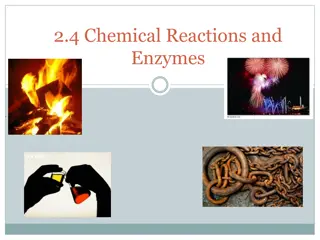Nuclear Reactions and Energy Release
Nuclear reactions, decay series, induced transmutation, and fission reactions explained with examples. Explore the energy release from Uranium-235 fission and its implications.
Download Presentation

Please find below an Image/Link to download the presentation.
The content on the website is provided AS IS for your information and personal use only. It may not be sold, licensed, or shared on other websites without obtaining consent from the author.If you encounter any issues during the download, it is possible that the publisher has removed the file from their server.
You are allowed to download the files provided on this website for personal or commercial use, subject to the condition that they are used lawfully. All files are the property of their respective owners.
The content on the website is provided AS IS for your information and personal use only. It may not be sold, licensed, or shared on other websites without obtaining consent from the author.
E N D
Presentation Transcript
Physics 4 March 12, 2020 P3 Challenge Indicate the decay series for 84 table of nuclides and report your answer in the format: 218??. Use the - 234?? until stable 238? 234?? 90 91 92 Get out 16, 17 and 23 for HMK check And Hand in the 7.1 Radioactivity Lab
Objectives/Agenda/Assignment Agenda: Objective: 7.2 Nuclear Applications Nuclear reactions Assignment: Fission p294 #18-24, except 23 Fusion And Worksheet 6-8 Energy from nuclear reactions
Nuclear decays as nuclear reactions The simplest type of nuclear reaction is a nuclear decay that is associated with the loss of an alpha or beta particle, like those we have written. These are all exothermic processes and release energy. The energy released comes from a loss of mass. m = reactants products E = mc2 or in Mev E = m*931.5 MeV
Induced Transmutation We can also induce nuclear reactions by bombarding nuclei with neutrons, protons, alpha particles or other particles including small atoms like oxygen. This is the purpose of a cyclotron. These nuclear reactions follow the same rules as nuclear decay processes. Ex: Alumunim-27 reacts with alpha particles to produce a neutron and another element. 27 + + + + 4 2 1 0 27 13 4 2 1 0 30 15 Al He n ??? Al He n P + + 27 13 4 2 1 0 30 15 Al He n ?? 13
Nuclear Fission In 1939, Lise Meitner and Otto Hahn discovered that when Uranium 235 is bombarded with neutrons a nuclear reaction happens that releases a large amount of energy. They isolated two daughter atoms and when comparing the mass defect of the proposed reaction, they could explain the amount of energy that they got from the reaction. Because of the split into two smaller atoms, this was called a fission reaction. In 1944, Hahn, but not Meitner, received the Nobel prize in Chemistry for the discovery of nuclear fission. Meitner, as a Jew, did the bulk of the work and calculations while living in exile from Hitler in Sweden but was denied credit. 235 1 140 92 0 56 U n Ba + + + n energy + 93 36 1 0 3 Kr
Energy of nuclear fission Let s figure out how much energy!!!! Use the table of nuclides to find relevant data. IB reports Es = 7.0 x 1013 J/kg for 235U 235 1 140 92 0 56 U n Ba + + + n energy + 93 36 1 0 3 Kr Mass of 235U nucleus = atomic mass 92 (me) = ? u Mass of 140Ba nucleus = atomic mass 56 (me) = ? u Mass of 93Kr nucleus = atomic mass 36 (me) = ? u m = (reactants products) = ? u Energy of this amount of mass in MeV/nucleus (Challenge in J/kg? Compare to specific energy listed.)
Chain reaction Because 3 neutrons are produced from the reaction, the products of one reaction can start the reaction of 3 new fissionable atoms. Because the natural abundance of U-235 is 0.7%, for natural uranium there is a limited chance that a neutron released will hit another fissionable atom. Isotopic enrichment is required using highly specialized centrifuges that can distinguish the different isotopes of uranium. The mass of U-235 required for a nuclear reaction to be sustained by the chain reaction is the critical mass. Samples with a mass greater than the critical mass are used to make weapons. Uncontrolled fission reactions are bombs. Controlled fission reactions are nuclear power plants.
Nuclear Fusion In addition to Fission reactions, nuclear fusion also releases energy. Note: All possible nuclear reactions go from less stable to more stable states with the release of some amount of energy. True for both natural decays and induced transmutations, including both fission and fusion reactions. Fusion is the nuclear process the sun uses to create energy. (3-10x more than fission) The H-bomb is an application of an uncontrolled Fusion reaction. We have not yet learned how to maintain a controlled fusion reaction. Why? Because Fusion requires a very high temperature to get the reaction to ignite.
Nuclear Fusion In the sun, the process is three steps: Two protons produce a deuterium, and a positron A third proton collides with the deuterium to form helium-3 and a gamma ray Two of the helium-3 nuclei collide to create a helium-4 nucleus and two extra protons. 41 0? + ?????? 1p 2 4He + 2 +1 The net reaction is A Holy grail of nuclear research is to achieve this kind of fusion reaction at or near room temperature. So called cold fusion . (Cold here means something less than 104 Kelvin. Even fusion at 100oC would be considered cold.) Fusion also doesn t use fuel rods so it doesn t create problematic nuclear waste from the spent fuel rods.
Nuclear reactions Fission: When a large atom is reacted with a neutron, it may form a nuclide that splits into two daughter nuclei. Ex: Fusion: When two small atoms collide to form a larger nuclide. Ex: Nuclides larger than Ni-62 may do fission. Smaller may do fusion. The energy of nuclear reactions is also related to it s mass changes.
Exit slip and homework Exit Slip What s due? (homework for a homework check next class) p294 #18-24, except 23, Binding WS #6-8 What s next? (What to read to prepare for the next class) Read 7.1, 7.2
